Showing posts with label Vacation. Show all posts
Showing posts with label Vacation. Show all posts
Monday, October 30, 2017
Thursday, October 26, 2017
Thursday Thirteen: Virginia Aquarium
We visited the Virginia Aquarium and Marine Science Center while we were in Virginia Beach last week.
It's very hands-on facility, and while I am never a fan of seeing anything behind glass or in cages (the critters always look sad to me), it was an interesting afternoon. We saw birds, komodo dragons, snakes, sharks, sting rays, lots of different fishes, read about the geology of the area and the meteorite that supposedly landed in the Chesapeake area a very long time ago, and felt pieces of said rock (it was soft and slippery).
Here are some photos of our afternoon. I don't know the real names of the things we looked at.
________
It's very hands-on facility, and while I am never a fan of seeing anything behind glass or in cages (the critters always look sad to me), it was an interesting afternoon. We saw birds, komodo dragons, snakes, sharks, sting rays, lots of different fishes, read about the geology of the area and the meteorite that supposedly landed in the Chesapeake area a very long time ago, and felt pieces of said rock (it was soft and slippery).
Here are some photos of our afternoon. I don't know the real names of the things we looked at.
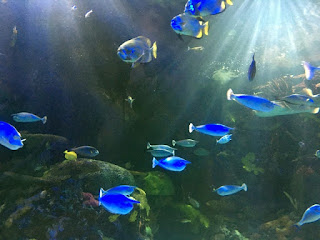 |
| Bright blue fish. |
 |
| Yellow fish |
 |
| Snouty fish. |
 |
| Sad-looking blue and yellow fish. |
 |
| A growing coral reef. |
 |
| A sea turtle. |
 |
| A striped old man fish. |
 |
| A bird. |
 |
| A yellow bird. |
 |
| A komodo dragon. |
 |
| Up close with the komodo dragon. |
 |
| Pink fish. |
________
Thursday Thirteen is played by lots of people; there is a list here if you want to read other Thursday Thirteens and/or play along. I've been playing for a while and this is my 523rd time to do a list of 13 on a Thursday.
Labels:
Thursday Thirteen,
Vacation,
Wildlife
Wednesday, October 25, 2017
Edgar Cayce Building
One of the buildings that caught my eye while we were in Virginia Beach was the Edgar Cayce building.
Edgar Cayce's Association for Research and Enlightenment was something I was familiar with, but not overly so. The place had a visitor center, so we stopped in.
Cayce was considered a psychic and he offered up a number of cures for various ailments. Therapies as divergent as salt packs, poultices, hot compresses, color healing, magnetism, vibrator treatment, massage, osteopathic manipulation, dental therapy, colonics, enemas, antiseptics, inhalants, homeopathics, essential oils, mud baths were prescribed. Substances used included oils, salts, herbs, iodine, witch hazel, magnesia, bismuth, alcohol, castoria, lactated pepsin, turpentine, charcoal, animated ash, soda, cream of tartar, aconite, laudanum, camphor, and gold solution. These were prescribed to overcome conditions that prevented proper digestion and assimilation of needed nutrients from the prescribed diet. The aim of the readings was to produce a healthy body, removing the cause of the specific ailment. Readings would indicate if the patient's recovery was problematic.
You might recognize a lot of that stuff from New Age holistic treatments today. Some of it I have tried; most I have not. I've tried magnets and they make me hurt. I tried castor oil on the weird issue with my stomach. I don't think it helped but I had very soft skin on my stomach for a while. Plus I discovered castor oil will eventually shrink a skin tag.
The visitor's center was essentially a New Age book store:
The facility has lectures and readings and things like that. Some were on fairly normal things; others on phenomenon like ESP. There is a garden labyrinth somewhere on the grounds that I did not see but would have liked to have looked at. It was difficult for me to get to without climbing stairs or wheedling my husband into driving around to find some place else to park.
The wares in the visitor's center were a bit pricy, so I bought nothing, but it was an interesting stop.
Edgar Cayce's Association for Research and Enlightenment was something I was familiar with, but not overly so. The place had a visitor center, so we stopped in.
You might call Edgar Cayce (1877-1945) the father of New Age. Or something like that. He was an American Christian mystic who answered questions on subjects as varied as healing, reincarnation, wars, Atlantis, and future events while claiming to be in a trance. A biographer gave him the nickname, "The Sleeping Prophet". A nonprofit organization, the Association for Research and Enlightenment, was founded to facilitate the study of Cayce's work.Cayce was considered a psychic and he offered up a number of cures for various ailments. Therapies as divergent as salt packs, poultices, hot compresses, color healing, magnetism, vibrator treatment, massage, osteopathic manipulation, dental therapy, colonics, enemas, antiseptics, inhalants, homeopathics, essential oils, mud baths were prescribed. Substances used included oils, salts, herbs, iodine, witch hazel, magnesia, bismuth, alcohol, castoria, lactated pepsin, turpentine, charcoal, animated ash, soda, cream of tartar, aconite, laudanum, camphor, and gold solution. These were prescribed to overcome conditions that prevented proper digestion and assimilation of needed nutrients from the prescribed diet. The aim of the readings was to produce a healthy body, removing the cause of the specific ailment. Readings would indicate if the patient's recovery was problematic.
You might recognize a lot of that stuff from New Age holistic treatments today. Some of it I have tried; most I have not. I've tried magnets and they make me hurt. I tried castor oil on the weird issue with my stomach. I don't think it helped but I had very soft skin on my stomach for a while. Plus I discovered castor oil will eventually shrink a skin tag.
The visitor's center was essentially a New Age book store:
The facility has lectures and readings and things like that. Some were on fairly normal things; others on phenomenon like ESP. There is a garden labyrinth somewhere on the grounds that I did not see but would have liked to have looked at. It was difficult for me to get to without climbing stairs or wheedling my husband into driving around to find some place else to park.
The wares in the visitor's center were a bit pricy, so I bought nothing, but it was an interesting stop.
Labels:
Vacation
Tuesday, October 24, 2017
Cape Henry Lighthouses
Our trip to Virginia Beach was different for us. For one thing, we never went into the ocean and barely set foot in the sand.
The weather was great - it never warmed above 76 or so, with cool evenings. There weren't a lot of folks on the beach, so we were not alone in looking for other things to do in the area.
We like history so we set out on Friday, October 20, to see the Cape Henry lighthouses.
The oldest of the two lighthouses there, which is also one of the oldest in the nation, is the first federally funded lighthouse. The government built it to guide maritime commerce at the mouth of the Chesapeake Bay. It stands near the “First Landing” site where English settlers arrived in 1607.
The structure, authorized by George Washington and overseen by Alexander Hamilton, was completed in 1792. It was designed by New York architect John McComb and it was used for about 100 years before being replaced by a cast iron lighthouse that still stands about 100 yards away.
Preservation Virginia acquired the Cape Henry Lighthouse in 1930. Over the years lighthouse and its surroundings have been restored including repairing the lantern after damage from Hurricane Barbara in 1953, repairing the damaged original Aquia sandstone and restoring the surrounding dunes.
Visitors to the Cape Henry Lighthouse can climb to the top of the tower.
Our first surprise occurred at the entrance. We thought this was a historic site - which it is - but it is also part of Fort Story, an active military base.
To get in to see the lighthouses, you must be searched and you must allow your car to be searched. If you go beyond a certain point, you will be arrested and charged with trespassing.
This is not exactly the welcome I've come to expect at historic sites.
When you accept the four-hour "historic site access pass" from the soldiers who declare you fit for entrance, you agree not to use text messaging or hands-free cellular telephones and to only photograph the historic sites.
I had never been searched before. It was intimidating though the soldiers were polite. They asked if we had any weapons and I produced a tiny little knife that I use sometimes to trim my nail cuticles with, and the guy waved it away like it was a plastic fork. My husband had his pocket knife and produced that, which was also waved away. Our drugs consisted of our prescriptions, and the only other thing in the car was my MS Surface which wasn't working so we'd stowed it in the trunk.
I would not have consented to any kind of body search but they didn't ask to do one. I would have asked to turn around and be allowed to leave had I been told that would be necessary. No one is touching me without reason, which is why I don't expect to ever get on an airplane again. I don't consider searching me - because that implies I have done something when I have not - to be a good reason to feel me up. I still believe in innocent until proven guilty, not the other way around. Searches assume you are guilty. (For the record, it is also why I don't go to many things at the local coliseum - I hate the searches, especially when they make women open their pocket books while the men walk in with guns holstered to their ankles, something I have personally observed. How stupid is that?)
The one thing it showed me is that the "land of the free" - isn't. And anyone who thinks otherwise is a fool.
I did wonder why, since there was a vast expanse of land between the historic areas and the closest military buildings, they didn't just move the checkpoints back behind the historic areas so the public could access them without all the rigmarole.
Anyway, this colored my appreciation of the historic structure quite a bit, and not in a good way.
It is nice that it is still there, though.
It is not so nice that my government considers me guilty of something simply because I want to see a historic structure that my tax dollars are keeping up. I'm sure others see searches like this differently, and simply accept it, but this is why I am not like everybody else. I have never been one to abide by arbitrary rules and accept the status quo.
The weather was great - it never warmed above 76 or so, with cool evenings. There weren't a lot of folks on the beach, so we were not alone in looking for other things to do in the area.
We like history so we set out on Friday, October 20, to see the Cape Henry lighthouses.
The oldest of the two lighthouses there, which is also one of the oldest in the nation, is the first federally funded lighthouse. The government built it to guide maritime commerce at the mouth of the Chesapeake Bay. It stands near the “First Landing” site where English settlers arrived in 1607.
The structure, authorized by George Washington and overseen by Alexander Hamilton, was completed in 1792. It was designed by New York architect John McComb and it was used for about 100 years before being replaced by a cast iron lighthouse that still stands about 100 yards away.
Preservation Virginia acquired the Cape Henry Lighthouse in 1930. Over the years lighthouse and its surroundings have been restored including repairing the lantern after damage from Hurricane Barbara in 1953, repairing the damaged original Aquia sandstone and restoring the surrounding dunes.
Visitors to the Cape Henry Lighthouse can climb to the top of the tower.
Our first surprise occurred at the entrance. We thought this was a historic site - which it is - but it is also part of Fort Story, an active military base.
To get in to see the lighthouses, you must be searched and you must allow your car to be searched. If you go beyond a certain point, you will be arrested and charged with trespassing.
This is not exactly the welcome I've come to expect at historic sites.
When you accept the four-hour "historic site access pass" from the soldiers who declare you fit for entrance, you agree not to use text messaging or hands-free cellular telephones and to only photograph the historic sites.
 |
| This happy little dolphin greets you. |
 |
| It immediately becomes not so happy when you realize you're on a military base. |
 |
| You were not supposed to take photos of personnel. I took these photos before I was told that and I have altered the faces and the license tag of the car in front of us. |
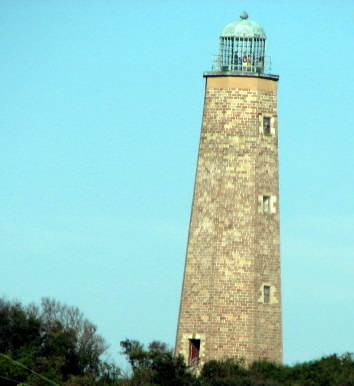 |
| This is the original 1792 lighthouse. |
 |
| This is both lighthouses as you approach them from the entrance. |
 |
| This is the new lighthouse. I don't think it is in use. |
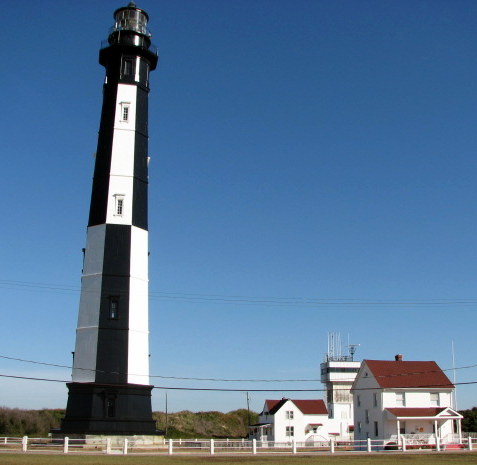 |
| No clue what the other buildings beside the lighthouse are. |
 |
| The old lighthouse. |
 |
| A nice poster in the gift shop. |
 |
| The lighthouses from the backside. |
 |
| The old lighthouse from the back side. |
I would not have consented to any kind of body search but they didn't ask to do one. I would have asked to turn around and be allowed to leave had I been told that would be necessary. No one is touching me without reason, which is why I don't expect to ever get on an airplane again. I don't consider searching me - because that implies I have done something when I have not - to be a good reason to feel me up. I still believe in innocent until proven guilty, not the other way around. Searches assume you are guilty. (For the record, it is also why I don't go to many things at the local coliseum - I hate the searches, especially when they make women open their pocket books while the men walk in with guns holstered to their ankles, something I have personally observed. How stupid is that?)
The one thing it showed me is that the "land of the free" - isn't. And anyone who thinks otherwise is a fool.
I did wonder why, since there was a vast expanse of land between the historic areas and the closest military buildings, they didn't just move the checkpoints back behind the historic areas so the public could access them without all the rigmarole.
Anyway, this colored my appreciation of the historic structure quite a bit, and not in a good way.
It is nice that it is still there, though.
It is not so nice that my government considers me guilty of something simply because I want to see a historic structure that my tax dollars are keeping up. I'm sure others see searches like this differently, and simply accept it, but this is why I am not like everybody else. I have never been one to abide by arbitrary rules and accept the status quo.
Monday, October 23, 2017
Tuesday, October 11, 2016
Jim Thorpe, the town
Jim Thorpe, PA is broken into two parts, separated by a river. The first part we reached ran up into the mountain, or so it seemed, but it had a Main Street appeal. The courthouse was located here along with many small shops and the visitors' center in a former train depot. The other side was less picturesque and was divided by a main road, 903, which went to the Pocono Racetrack and beyond.
See my previous post for information on how the town came to be known as Jim Thorpe.
Jim Thorpe was originally known at Mauch Chunk, which are the Lenni Lenape (Native Americans) words for "sleeping bear."
The coal-mining town was incorporated in 1850, though the first settlement of the area occurred in 1818 with the construction of 40 buildings on 400 acres.
At one time, 19 of the country's 26 millionaires had a residence in Mauch Chunk, according to the visitor's guide. I guess that was back in the 1800s or early 1900s - the book didn't say exactly when this was.
We enjoyed walking the two blocks I could manage.
See my previous post for information on how the town came to be known as Jim Thorpe.
 |
| The Main Street of Jim Thorpe. |
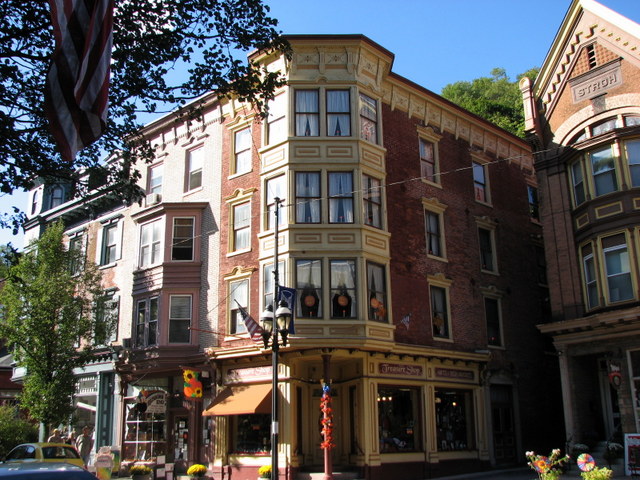 |
| The buildings were all very well cared for and in use. This was no ghost town, for sure. |
 |
| Jim Thorpe Courthouse |
 |
| Looking back toward the courthouse. |
We enjoyed walking the two blocks I could manage.
 |
| Another book store! Hurray! |
 |
| The structures are very small-town America in style. |
 |
| Jim Thorpe has been called the "Switzerland of America." |
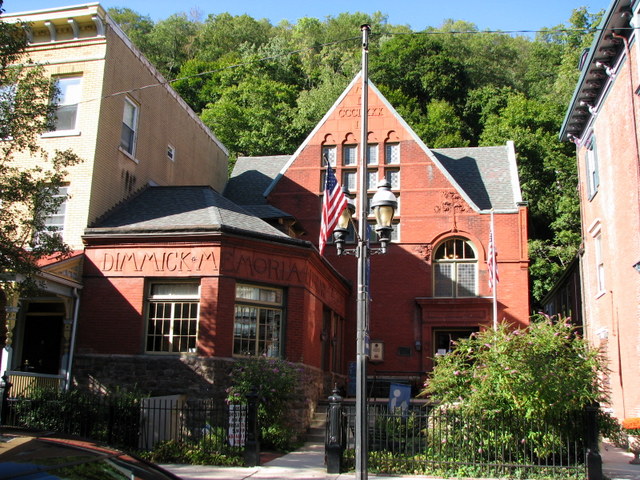 |
| This was the town library. The structure was built in 1889. |
 |
| I wanted to go in but could not find a handicapped access. |
 |
| Anthracite coal is what made this little community. |
 |
| My husband with a big piece of anthracite coal. |
Labels:
Vacation
Monday, October 10, 2016
Jim Thorpe Memorial
During our adventures in Pennsylvania in the last week of September, we ran across a memorial to Jim Thorpe.
Jim Thorpe (1887-1953) was an American athlete who achieved fame in the 1912 Olympics, where he received gold medals in the 1912 pentathlon and decathlon. He also played football (collegiate and professional), and professional baseball and basketball. He lost his Olympic titles because later it was learned that he had been paid for playing two seasons of semi-professional baseball before competing in the Olympics. This violated rules in place then.
In 1983, 30 years after his death, the International Olympic Committee (IOC) restored his Olympic medals.
Interestingly, Thorpe grew up in Oklahoma. He was a member of the Sac and Fox Nation and thus of Native American heritage. He was the first Native American to medal in the Olympics.
He was also the first president of what eventually would become the National Football League.
An ABC Sports poll called Thorpe the greatest American athlete ever, beating out others like Ali and Michael Jackson.
Thorpe died in California. He never lived in Pennsylvania. He ended up buried in Pennsylvania allegedly because his third wife "stole" his body as it lay in state. Apparently, she heard that the small Pennsylvania towns of Mauch Chunk and East Mauch Chunk (now called Jim Thorpe) were seeking to attract business. She made a deal with officials which, according to Thorpe's son Jack, was done for monetary considerations. Mauch Chunk and East Mauch Chunk bought Thorpe's remains, erected a monument to him, merged, and renamed the newly united town in his honor, even though Thorpe had never been there.
The monument site contains his tomb, two statues of him in athletic poses, and historical markers describing his life story.
Thorpe's son, Jack, in 2010 attempted to have his father's remains relocated to Oklahoma, but in 2014 a U.S. Appeals Court ultimately ruled that the remains should stay where they are, and the U.S. Supreme Court refused to hear another appeal, which ended the matter.
 |
| Part of the Jim Thorpe Memorial. |
Jim Thorpe (1887-1953) was an American athlete who achieved fame in the 1912 Olympics, where he received gold medals in the 1912 pentathlon and decathlon. He also played football (collegiate and professional), and professional baseball and basketball. He lost his Olympic titles because later it was learned that he had been paid for playing two seasons of semi-professional baseball before competing in the Olympics. This violated rules in place then.
In 1983, 30 years after his death, the International Olympic Committee (IOC) restored his Olympic medals.
 |
| Hubby reading the memorial information. |
Interestingly, Thorpe grew up in Oklahoma. He was a member of the Sac and Fox Nation and thus of Native American heritage. He was the first Native American to medal in the Olympics.
He was also the first president of what eventually would become the National Football League.
 |
| Jim Thorpe with a football. |
Thorpe died in California. He never lived in Pennsylvania. He ended up buried in Pennsylvania allegedly because his third wife "stole" his body as it lay in state. Apparently, she heard that the small Pennsylvania towns of Mauch Chunk and East Mauch Chunk (now called Jim Thorpe) were seeking to attract business. She made a deal with officials which, according to Thorpe's son Jack, was done for monetary considerations. Mauch Chunk and East Mauch Chunk bought Thorpe's remains, erected a monument to him, merged, and renamed the newly united town in his honor, even though Thorpe had never been there.
The monument site contains his tomb, two statues of him in athletic poses, and historical markers describing his life story.
 |
| Thorpe's burial monument. |
Thorpe's son, Jack, in 2010 attempted to have his father's remains relocated to Oklahoma, but in 2014 a U.S. Appeals Court ultimately ruled that the remains should stay where they are, and the U.S. Supreme Court refused to hear another appeal, which ended the matter.
 |
| Facts about Jim Thorpe. |
 |
| Jim Thorpe with a discus. |
 |
| Thorpe's memorial. |
 |
| Hubby reading more information. |
 |
| Full picture of one of Thorpe's statues. |
Labels:
Vacation
Friday, October 07, 2016
More Martin Guitars
If you want to hear current owner Chris Martin give a tour of the Martin Museum and offer an explanation of how Martin Guitars came to be, check out this link, which has a video tour in numerous parts. If you have any interest in learning about guitar history, this is an interesting video series.
Wednesday, September 28, 2016, we visited the Martin Museum, located at the factory, after we toured the factory. With the guitars behind glass, it was difficult to obtain decent pictures.
Many well-known people have played Martin guitars, including Joan Baez, Eric Clapton, Johnny Cash, Elvis Presley, Willie Nelson, Kurt Cobain, Gene Autry, Sting, Paul Simon, Jimmy Buffet, Jimmy Page, Tom Petty - the list goes on. Most well-known musicians apparently own or owned a Martin guitar.
To see better photos of the one millionth guitar, check this link for the back and this link for the front.
I would guess the company should be coming up on its 1,500,000 guitar soon, if it hasn't already surpassed that.
Guitars are lovely to look at, and beautiful to play. Music is a wonderful hobby and it's worth playing if only for yourself. Don't ever let anyone tell you that picking up a guitar is a waste of time. Do it for yourself. After all, it's your life. Make it sing.
Wednesday, September 28, 2016, we visited the Martin Museum, located at the factory, after we toured the factory. With the guitars behind glass, it was difficult to obtain decent pictures.
Many well-known people have played Martin guitars, including Joan Baez, Eric Clapton, Johnny Cash, Elvis Presley, Willie Nelson, Kurt Cobain, Gene Autry, Sting, Paul Simon, Jimmy Buffet, Jimmy Page, Tom Petty - the list goes on. Most well-known musicians apparently own or owned a Martin guitar.
 |
| A wall of musicians who have or have played Martin guitars. |
 |
| Some newer guitars. |
 |
| I think this was the 500,000 Martin guitar but I am not sure. If so, it was built in 1990. |
 |
| Older guitars looked like this. Not much different than what you see today, eh? |
 |
| A story of how Martin came to Nazareth, PA. |
 |
| More guitars owned by famous people. |
 |
| This is the one millionth guitar, produced in 2004. It took three years to build. Its value is $1 million. |
 |
| This is the front of the guitar. |
 |
| More guitars played by famous people. |
 |
| This was Andy Griffith's guitar. |
Guitars are lovely to look at, and beautiful to play. Music is a wonderful hobby and it's worth playing if only for yourself. Don't ever let anyone tell you that picking up a guitar is a waste of time. Do it for yourself. After all, it's your life. Make it sing.
Subscribe to:
Posts (Atom)






